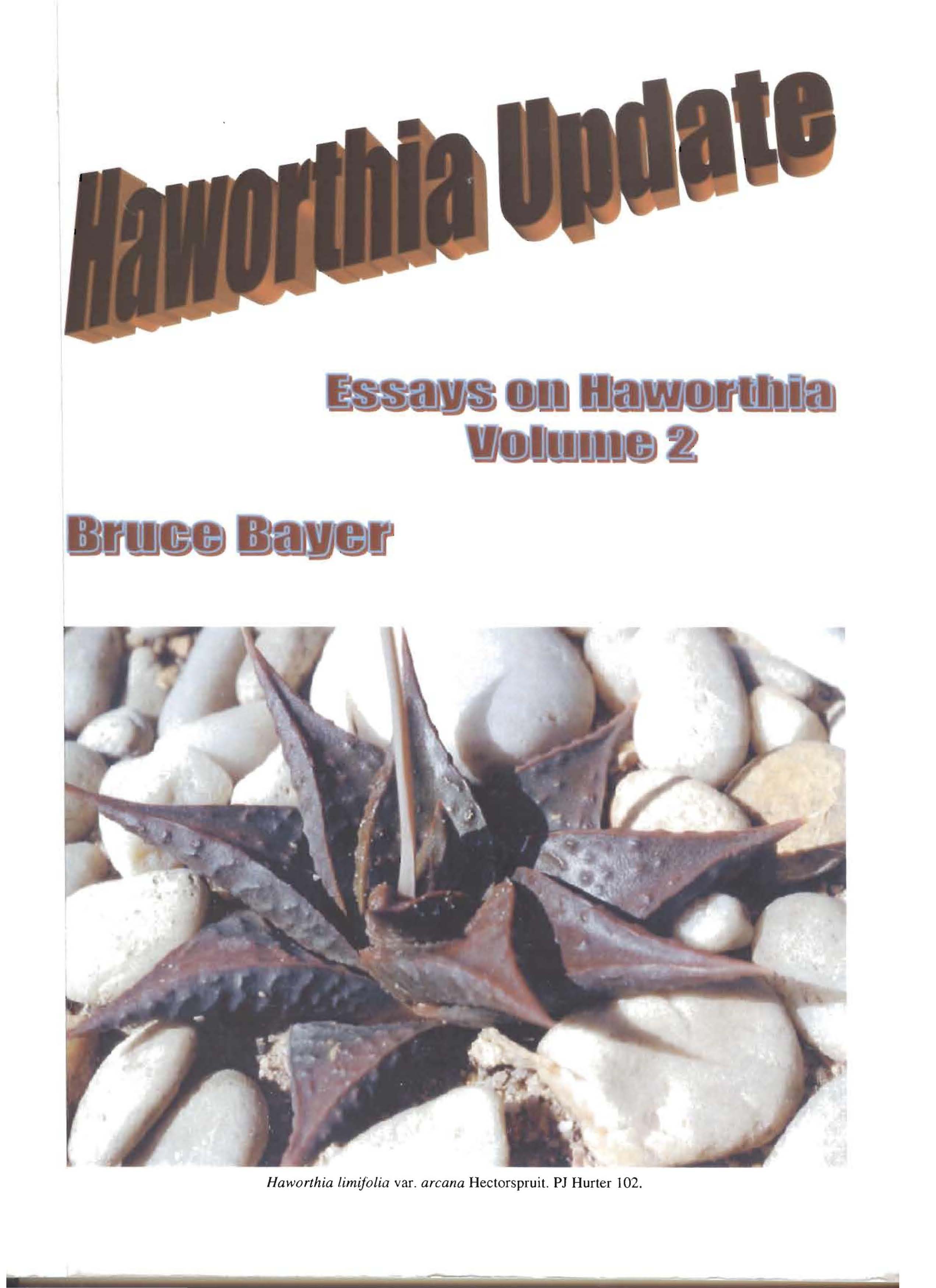
- Volume 2, Introduction and Acknowledgement
- Volume 2, Catalyst and Consequence
- Volume 2, Chapter 1:- The curious variability of Haworthia floribunda
- Volume 2, Chapter 2:- A population of Haworthia magnifica/maraisii
- Volume 2, Chapter 3:- Where to Haworthia limifolia
- Volume 2, Chapter 4:- Haworthia limifolia var. arcana Smith & Crouch
- Volume 2, Chapter 5:- The White Widow Reunion – Haworthia mutica
- Volume 2, Chapter 6:- How to understand Haworthia mutica var. nigra
- Volume 2, Chapter 7:- Continuity of Haworthia on the Zuurberg
- Volume 2, Chapter 8:- Ecotypes in Haworthia
- Volume 2, Chapter 9:- New Names and Combinations in Haworthia
- Volume 2, Chapter 10:- Small Hairy Things
- Volume 2, Chapter 11:- Some of the interplay of H. arachnoidea and H. mucronata
- Volume 2, Chapter 12:- Haworthia rossouwii Poelln. and the demise of H. serrata Bayer
- Volume 2, Chapter 13:- A trip to Bredasdorp
- Volume 2, Chapter 14:- Explaining the name Haworthia intermedia VPoelln. and others
- Volume 2, Chapter 15:- Electron Scanning Photographs of Haworthia leaf surfaces
- Volume 2, Chapter 16:- Nectar Sugars in the Alooid minor genera and a need for another model
- Volume 2, Chapter 17:- Species and varieties listed
- Volume 2, Chapter 18:- Bayer Accessions
Editor’s Note
Bruce Bayer’s Haworthia Updates 2 & 3 have been long expected and long in print. Too long in fact, but with the benefit that some of the newest findings and literature can now be covered. Bruce has continued, and still continues, with his field research, which never ceases to bring to light new information about haworthias. Since Haworthia Revisited, he has added nearly 1000 new population records and taken innumerable photographs. Over 1000 photographs are published in Updates 2 & 3 which, in themselves, form an informative record of the variability of haworthias and demonstrate the fundamental problem of classifying haworthias. The photographs are referenced to location and topography. They record information which far exceeds that of practical herbarium records, consequently they will be of value, and indeed essential, to anyone engaging in the taxonomy of the genus at whatever level, and especially to the aficionado, grower and collector. Some pictures are substandard for a coffee-table presentation, but these are far in the minority. They have been retained as the images still convey useful, broad information and it is not possible, for a variety of reasons, to retake them.
The two volumes include 33 essays, 1 to 18 in Vol.2 and 1 to 15 in Vol. 3. The chapters are often independent, consequently the very large number of illustrations and maps are numbered sequentially from 1 for each chapter. Many photographs have the same name. What is distinctive for each photograph is the collection number and the location details. Some of the chapters have been published previously elsewhere but, because of the unfortunate fragmentation of the literature, Bruce would like them presented in a single comprehensive publication to make them all more accessible and contextually meaningful. Often there are addenda to these chapters to present additional argumentation and explanation and corrections have been made to compensate for errors in the original printings. There is emphasis on taxonomy as a means to understanding and knowing plants – as opposed to the general view that taxonomy is petty argumentation about names.
Bruce has included relevant references for articles he has commented upon, which some people might wish to consult. Some are not readily available to the general public or are available only though arrangement with libraries. However, as the policy of Alsterworthia International is to promote and facilitate without favour the publication of information about the genera of the Alooideae (Asphodelaceae), a number of these articles can also be consulted in Alsterworthia International publications. They have been reprinted with permission. Alsterworthia International also has a number of the books for sale. Details will be found on pages ii & ii at the back of this book. As editor of Haworthiad from 1995 to 2001 and of Alsterworthia International from 2001 I have had the privilege of printing articles in both journals from a number of authors including Bruce. It is now an honour and a delight to publish Bruce Bayer’s revised Updates 2 & 3. They provide a wealth of information, which he has collected during time-consuming field research over several decades. Few, if any, can equal his field work. The detailed information he has collected about haworthias is now available for all to consult and use, though if the past is any guide to the future, interpretations about the classification of haworthias may still be subject to some divergence. Finally, I would like to express my thanks to Bruce Bayer for checking the first proof and to Steven Hammer for the final check. Any residual errors may be attributed to me.
.~ Harry Mays
